Effect of Sintering Temperatures on Grain Coarsening Behaviors and Mechanical Properties of W-NiTi Heavy Tungsten Alloys
Abstract
:1. Introduction
2. Materials and Methods
3. Results and Discussions
4. Conclusions
Author Contributions
Funding
Institutional Review Board Statement
Informed Consent Statement
Data Availability Statement
Conflicts of Interest
References
- Lassner, E.; Schubert, W.D. Tungsten: Properties, Chemistry, Technology of the Element, Alloys, and Chemical Compounds; Springer: Berlin, Germany, 1999. [Google Scholar]
- Rieth, M.; Dudarev, S.L.; Gonzalez de Vicente, S.M.; Aktaa, J.; Ahlgren, T.; Antusch, S.; Armstrong, D.E.J.; Balden, M.; Baluc, N.; Barthe, M.F.; et al. Recent progress in research on tungsten materials for nuclear fusion applications in Europe. J. Nucl. Mater. 2013, 432, 482–500. [Google Scholar] [CrossRef] [Green Version]
- Lu, W.R.; Gao, C.Y.; Ke, Y.L. Constitutive modeling of two-phase metallic composites with application to tungsten-based composite 93W–4.9Ni–2.1Fe. Mater. Sci. Eng. A 2014, 592, 136–142. [Google Scholar] [CrossRef]
- Mondal, A.; Upadhyaya, A.; Agrawal, D. Microwave and conventional sintering of 90W–7Ni–3Cu alloys with premixed and prealloyed binder phase. Mater. Sci. Eng. A 2010, 527, 6870–6878. [Google Scholar] [CrossRef]
- Chen, C.-L.; Ma, S.-H. Effects of Ni/Co ratio and mechanical alloying on characteristics and sintering behavior of W-Ni-Co tungsten heavy alloys. J. Alloy. Compd. 2017, 711, 488–494. [Google Scholar] [CrossRef]
- Şahin, Y. Recent Progress in Processing of Tungsten Heavy Alloys. J. Powder Technol. 2014, 2014, 764306. [Google Scholar] [CrossRef]
- German, R.M.; Suri, P.; Park, S.J. Review: Liquid phase sintering. J. Mater. Sci. 2009, 44, 1–39. [Google Scholar] [CrossRef] [Green Version]
- Dong, H.; Li, P.; Ai, T.; Li, W. Mechanical Properties and Microstructure of W-6Ni-4Co Alloy by a Two-Step Sintering Process. Metals 2019, 9, 680. [Google Scholar] [CrossRef] [Green Version]
- Ryu, H.J.; Hong, S.H.; Baek, W.H. Mechanical alloying process of 93W-5.6 Ni-1.4 Fe tungsten heavy alloy. J. Mater. Processing Technol. 1997, 63, 292–297. [Google Scholar] [CrossRef]
- Li, X.; Hu, K.; Qu, S.; Li, L.; Yang, C. 93W–5.6Ni–1.4Fe heavy alloys with enhanced performance prepared by cyclic spark plasma sintering. Mater. Sci. Eng. A 2014, 599, 233–241. [Google Scholar]
- Xiang, D.P.; Ding, L.; Li, Y.Y.; Chen, X.Y.; Zhang, T.M. Fabricating fine-grained tungsten heavy alloy by spark plasma sintering of low-energy ball-milled W–2Mo–7Ni–3Fe powders. Mater. Sci. Eng. A 2013, 578, 18–23. [Google Scholar] [CrossRef]
- Satyanarayana, P.; Sokkalingam, R.; Jena, P.; Sivaprasad, K.; Prashanth, K. Tungsten matrix composite reinforced with cocrfemnni high-entropy alloy: Impact of processing routes on microstructure and mechanical properties. Metals 2019, 9, 992. [Google Scholar] [CrossRef]
- Shao, Y.; Ma, H.; Cui, L. Fine-grained W-NiTi heavy alloys with enhanced performance. Mater. Sci. Eng. A 2018, 729, 357–361. [Google Scholar] [CrossRef]
- Ma, H.; Shao, Y.; Shek, C.H. Microstructure, grain growth behavior and mechanical properties of W-CoCuFeNi tungsten heavy alloys prepared by infiltration. Int. J. Refract. Met. Hard Mater. 2021, 98, 105572. [Google Scholar] [CrossRef]
- Shao, Y.; Guo, F.; Huan, Y.; Jiang, D.; Zhang, J.; Ren, Y.; Cui, L. Fabrication, microstructure and mechanical properties of W NiTi composites. J. Alloy. Compd. 2017, 695, 1976–1983. [Google Scholar] [CrossRef] [Green Version]
- Park, S.; Martin, J.; Guo, J.; Johnson, J.L.; German, R.M. Grain growth behavior of tungsten heavy alloys based on the master sintering curve concept. Metall. Mater. Trans. A 2006, 37, 3337–3346. [Google Scholar] [CrossRef] [Green Version]
- Dinçer, O.; Pehlivanoğlu, M.K.; Çalişkan, N.K.; Karakaya, İ.; Kalkanli, A. Processing and microstructural characterization of liquid phase sintered tungsten–nickel–cobalt heavy alloys. Int. J. Refract. Met. Hard Mater. 2015, 50, 106–112. [Google Scholar] [CrossRef]
- Fan, J.L.; Gong, X.; Huang, B.Y.; Song, M.; Liu, T.; Tian, J.M. Densification behavior of nanocrystalline W–Ni–Fe composite powders prepared by sol-spray drying and hydrogen reduction process. J. Alloy. Compd. 2010, 489, 188–194. [Google Scholar] [CrossRef]
- Ding, L.; Xiang, D.P.; Li, Y.Y.; Li, C.; Li, J.B. Effects of sintering temperature on fine-grained tungsten heavy alloy produced by high-energy ball milling assisted spark plasma sintering. Int. J. Refract. Met. Hard Mater. 2012, 33, 65–69. [Google Scholar] [CrossRef]

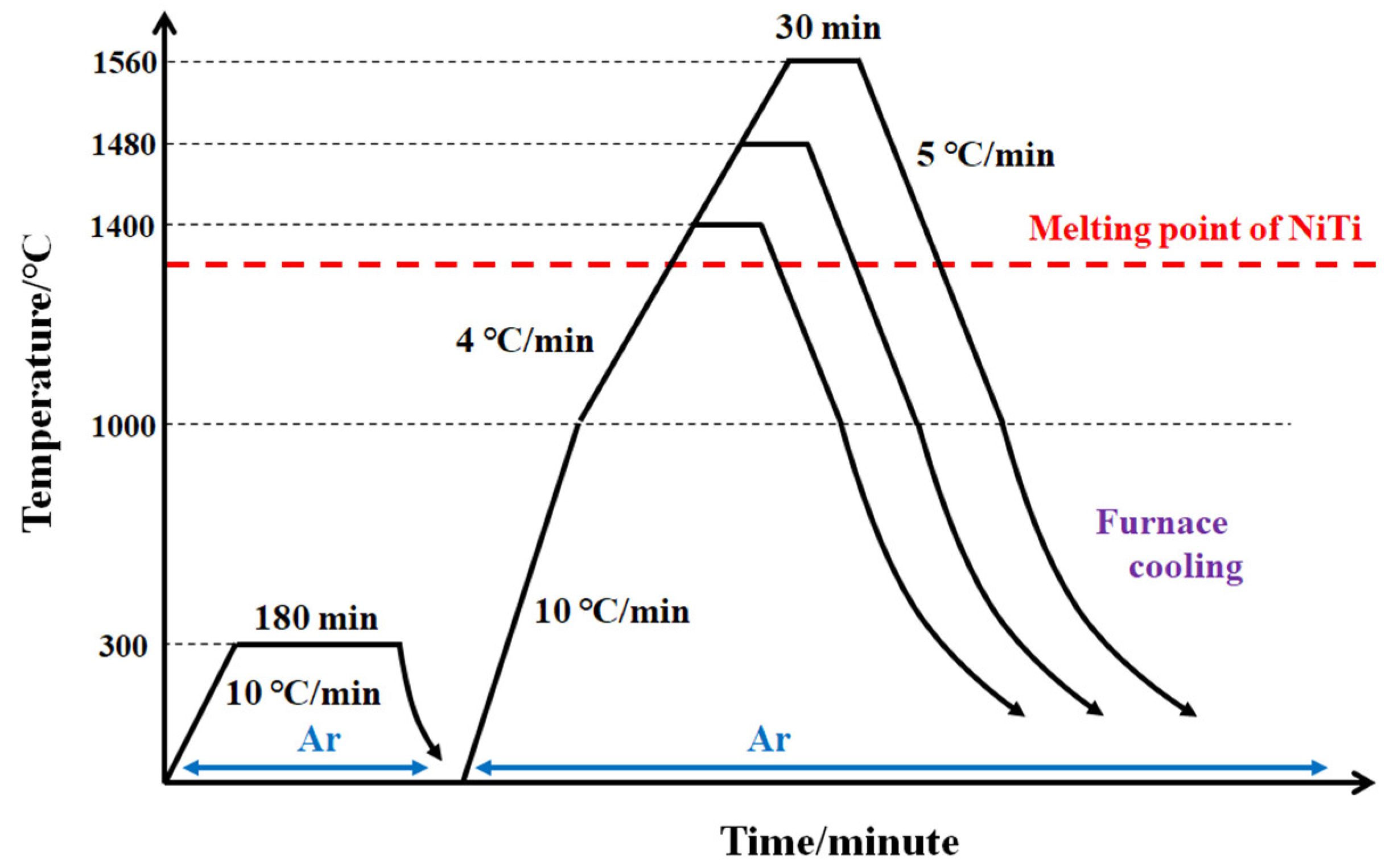
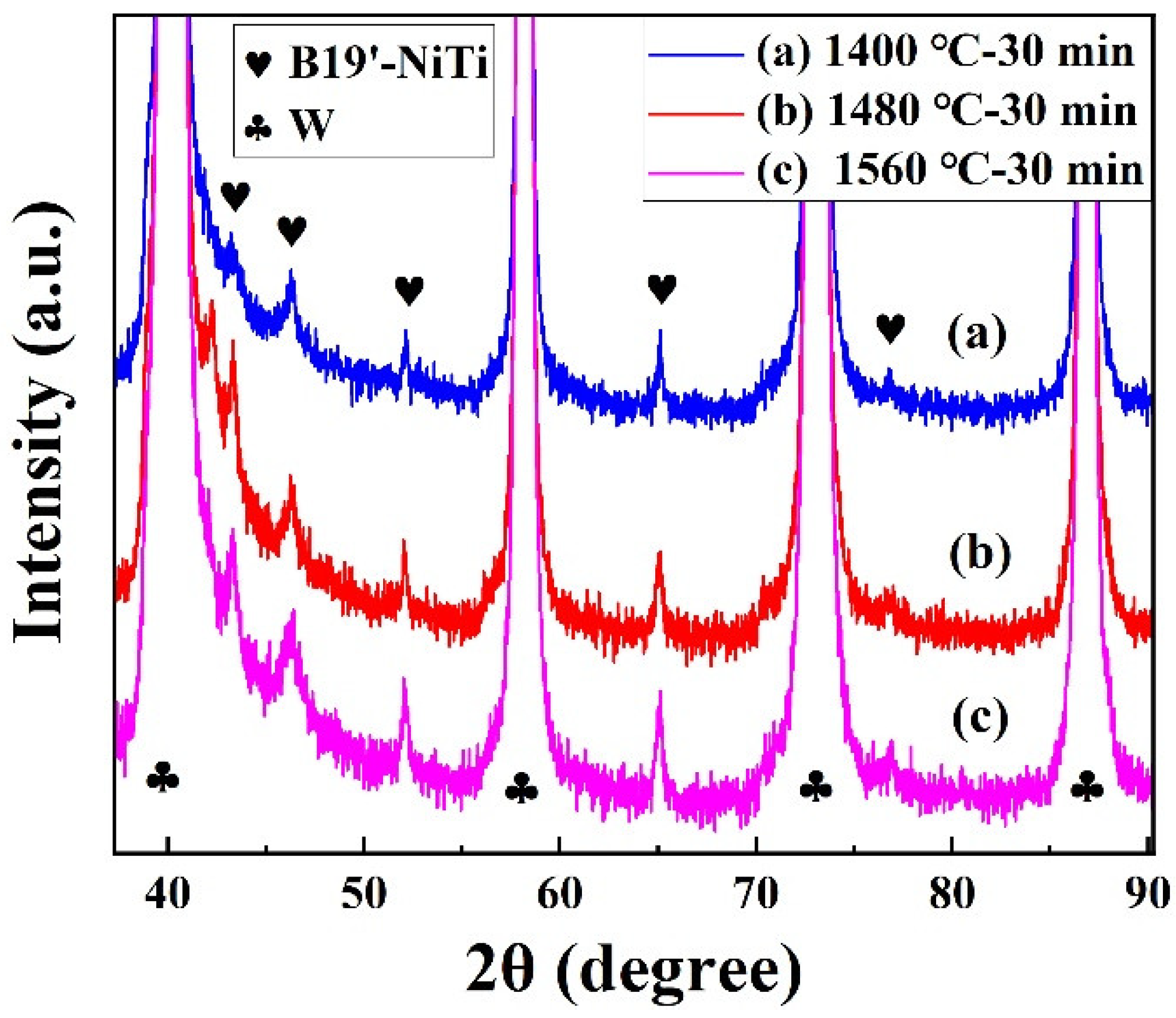
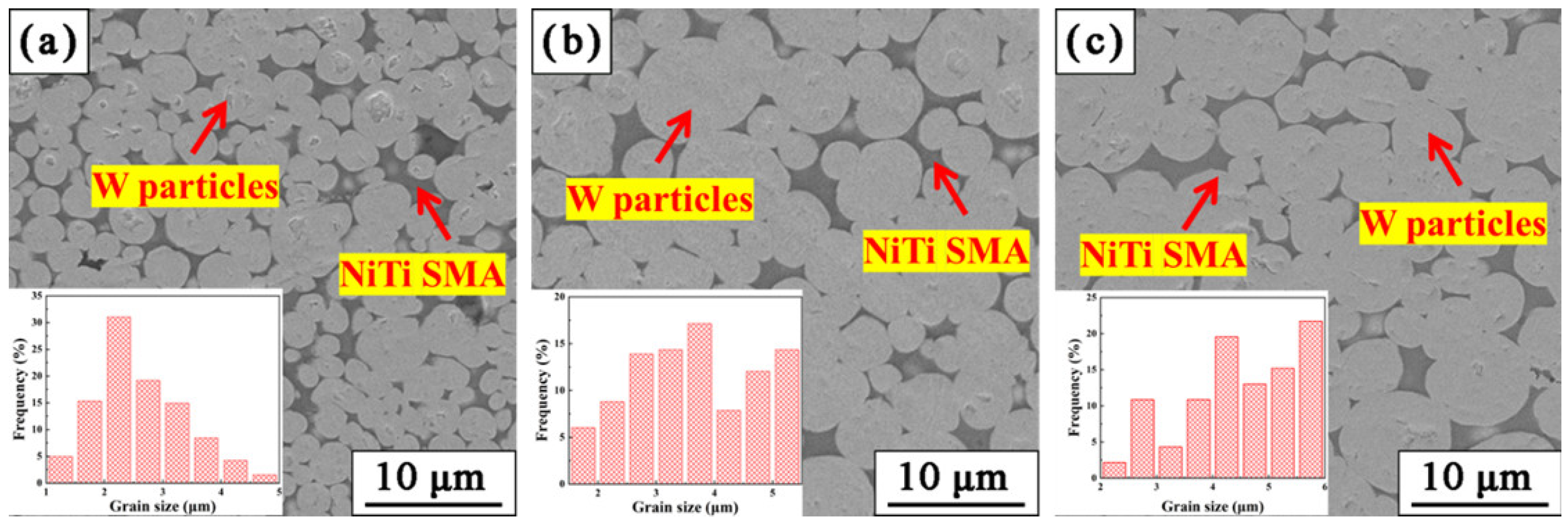

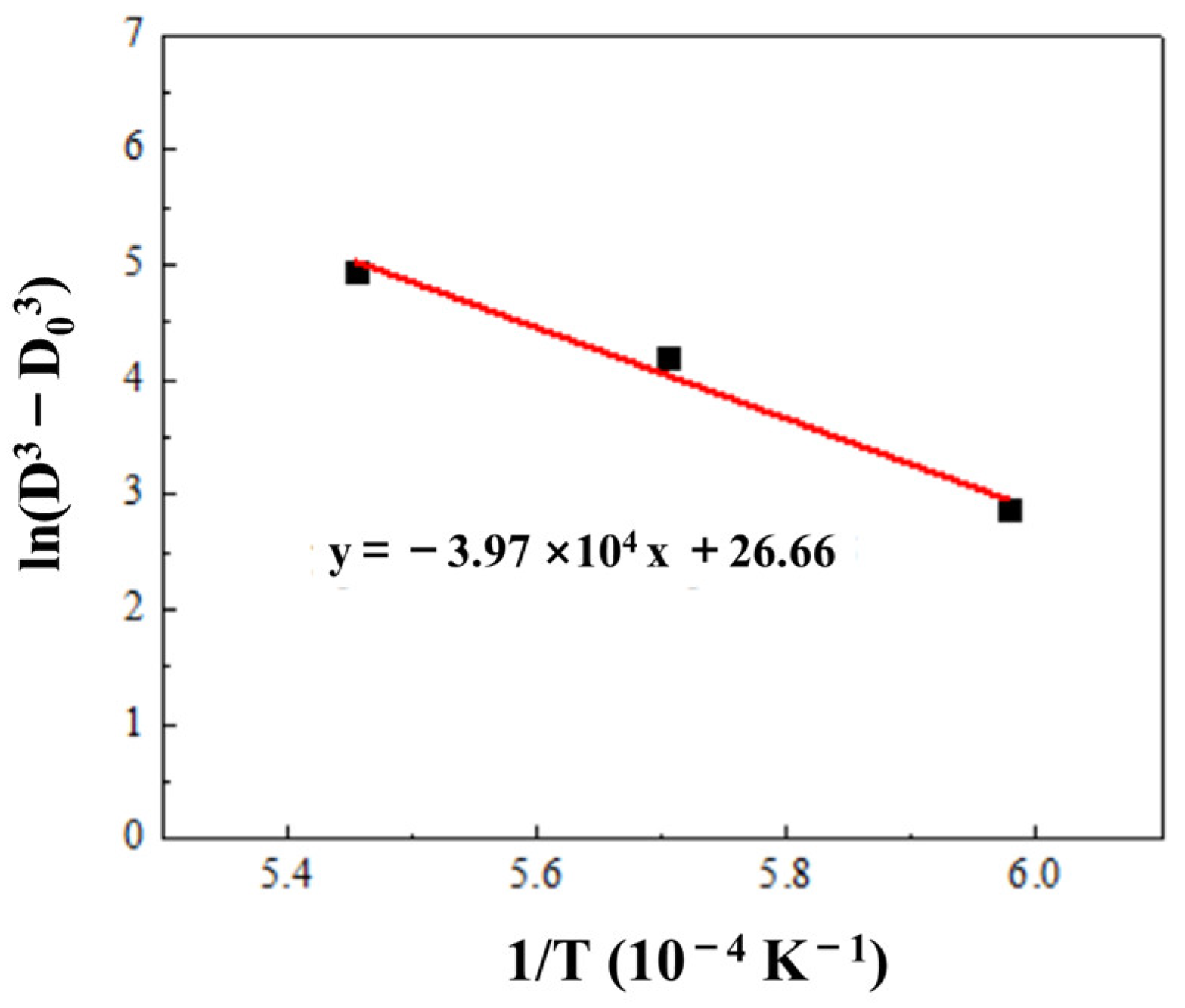

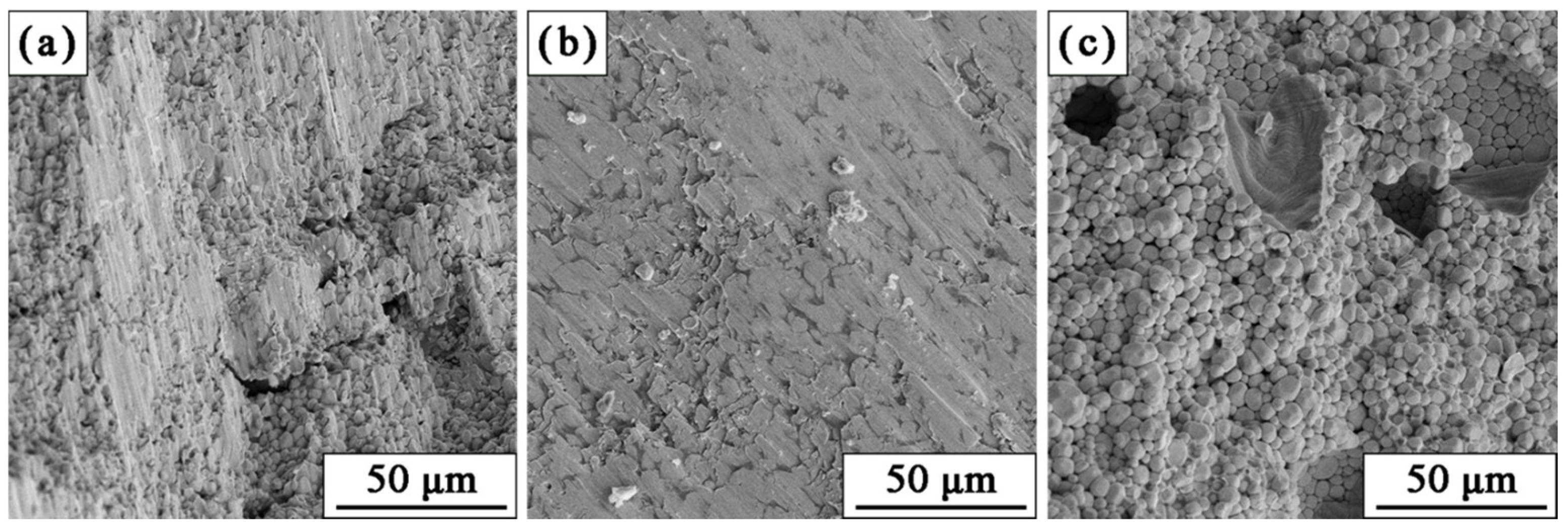
Publisher’s Note: MDPI stays neutral with regard to jurisdictional claims in published maps and institutional affiliations. |
© 2022 by the authors. Licensee MDPI, Basel, Switzerland. This article is an open access article distributed under the terms and conditions of the Creative Commons Attribution (CC BY) license (https://creativecommons.org/licenses/by/4.0/).
Share and Cite
Shao, Y.; Yu, W.; Wu, J.; Ma, H. Effect of Sintering Temperatures on Grain Coarsening Behaviors and Mechanical Properties of W-NiTi Heavy Tungsten Alloys. Materials 2022, 15, 8035. https://doi.org/10.3390/ma15228035
Shao Y, Yu W, Wu J, Ma H. Effect of Sintering Temperatures on Grain Coarsening Behaviors and Mechanical Properties of W-NiTi Heavy Tungsten Alloys. Materials. 2022; 15(22):8035. https://doi.org/10.3390/ma15228035
Chicago/Turabian StyleShao, Yang, Weikang Yu, Jifei Wu, and Haiwen Ma. 2022. "Effect of Sintering Temperatures on Grain Coarsening Behaviors and Mechanical Properties of W-NiTi Heavy Tungsten Alloys" Materials 15, no. 22: 8035. https://doi.org/10.3390/ma15228035





